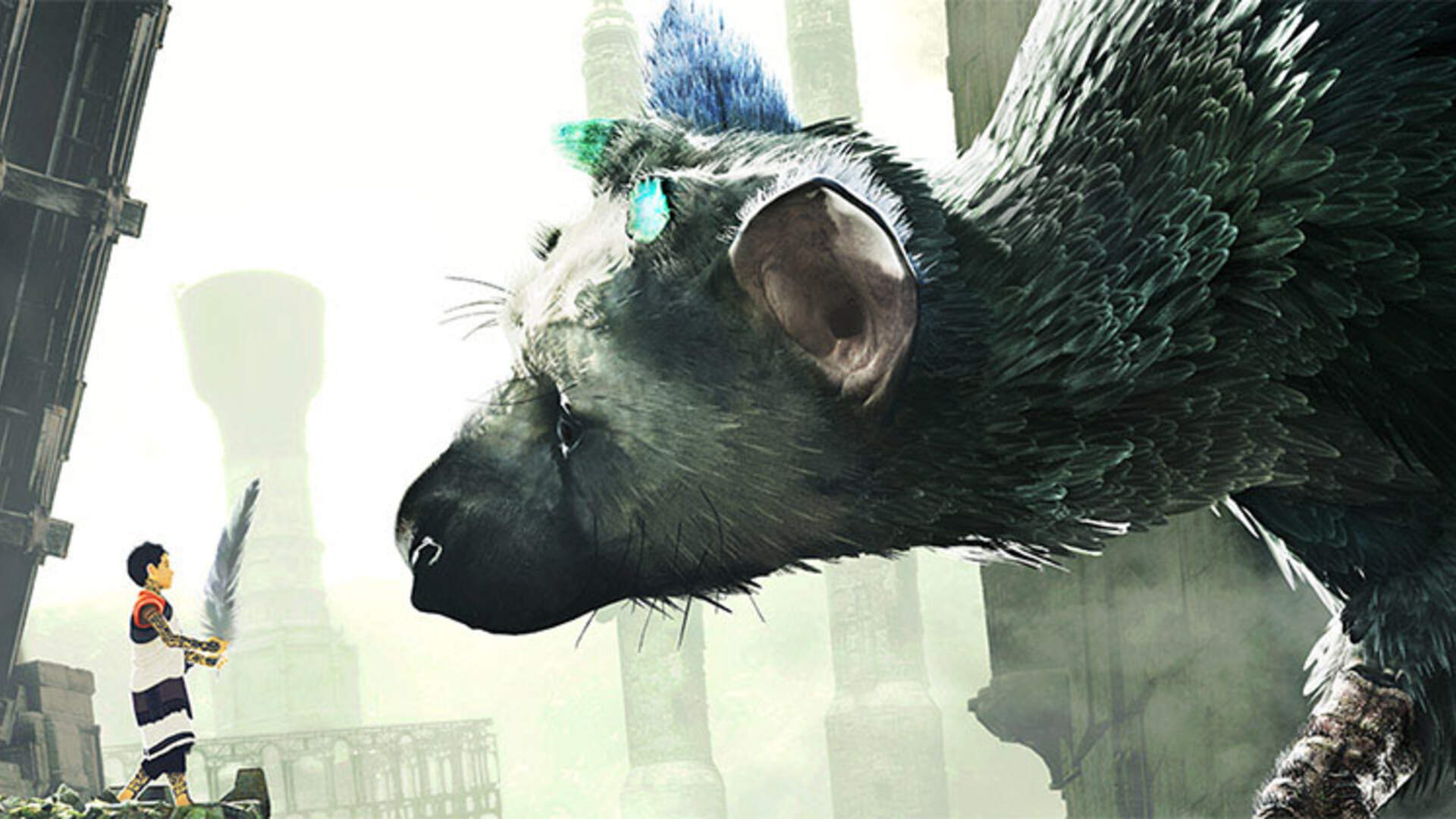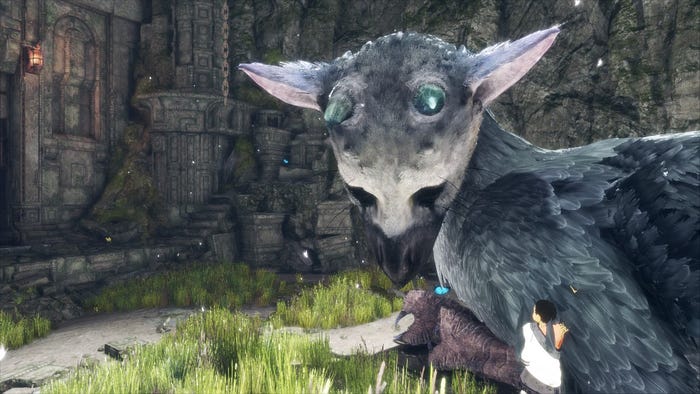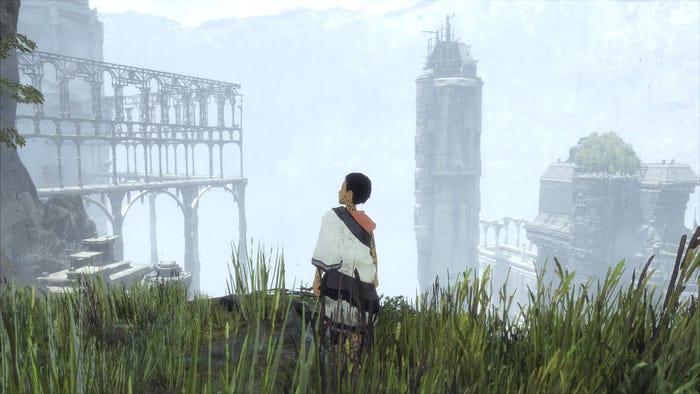Revisiting The Last Guardian
Does this flawed, beautiful masterpiece hold up five years later?

I waited for The Last Guardian for nearly ten years. Work for the next game by famed auteur Fumito Ueda began shortly after the release of Shadow of the Colossus in late 2005. Up until that point, Ueda and his Team Ico had made an impressive name for themselves from the release of only two games. Those two games served to not only redefine our treatment of video games as art, but also as projects that felt more like arthouse films than games.

Castle in the Mist
I played both Ico and Shadow of the Colossus near release on the Playstation 2, in my mid-teens. Like many who played them at the time, this duology felt to me so far removed from other video games that they became the sole repeated argument for video games as an art medium. Fumito Ueda’s clarity of vision was palpable, his games sharing similar themes of humanism and silent depth, featuring worlds deeply forested that were replete with ancient temples, fog, and overly saturated light.
Ueda and Team Ico shared the foundational belief that story should serve gameplay, and not the other way around. Their games were about efficiency, about less. Anyone who has played Ico or Shadow of the Colossus has no doubt been impressed by the negative space of the games, by how little dialogue and story there is, but also by how deeply emotional and nuanced each adventure manages to be.
After Shadow of the Colossus, expectations were high. Ico had certainly been a creative darling, and more moderately received than Shadow, which wowed critics and fans alike with its intensity and breadth. On the Playstation 2, Shadow of the Colossus was such an immersive experience that it clung to the player far beyond its meager ten hours. It was a game of interaction and obstacles, a game of living dungeons, a game that felt “open world” in a way that no other game had up until that point. Where Ico felt like stepping into a French painting, Shadow of the Colossus felt like sinking into a dream.
Fumito Ueda’s worlds, so lovingly crafted, do not feel like set pieces that solely exist for the function of the player. They instead feel like worlds that have existed for hundreds and thousands of years, into which we exist as but a visitor to an infinitesimally small piece.

Renaissance Man and Monster
While Ueda often claims that the messages of his games are to be determined by the player, the melancholy they exude is obvious.
“When I first showed my staff the sequence of sad-sounding music being played after defeating a colossus in Shadow of the Colossus, they thought it was a bug and laughed because they were so used to games that would play a fanfare after defeating a monster.” Ueda, Gamasutra 2019
Fumito Ueda has never been dismissive of violence as a storytelling device, but when his games do delve into violence it’s decisive and impactful. The violence in Ico functioned as a means of defense; in Shadow of the Colossus it was out of desperation.
The Last Guardian, in so many ways, was a different game.
Announced at E3 in 2009, it wouldn’t be until E3 2015 that we would see the real, functional game. When the release finally rolled out in 2016, both fans and skeptics had given up hope on the title ever releasing at all. While the final game was functionally similar to Ueda’s 2009 design, the actual development of The Last Guardian had been more than rocky — it was nightmarish.
By 2011, Ueda had left Sony, frustrated and ashamed of what had become of the project. Still under contract, he utilized many former Team Ico members to create genDESIGN, a new development team that eventually finalized the release of The Last Guardian with some outside help from members of other Sony studios. It had always been a pet project, but over the years The Last Guardian transformed into a myth.
When it finally released, it did so to mixed reviews.
While Ico and Shadow of the Colossus have long been heralded for their beauty, design, worlds, and impact, they’ve been dually criticized for their controls and camera. Fumito Ueda is an auteur in many ways, and his impressive constructive ability cannot be understated, but these games are not without their flaws. The Last Guardian turned out to be no different, though this time the flaws felt less like intentional segments left in a Persian rug and more like the inescapable shortcomings of a frustrated artist.

A Boy and His Bird-Dog
I deeply love The Last Guardian, and after a second play-through, I feel it even more than I remembered. My love for the game can overcome its shortcomings. It can forgive what is very obviously a Playstation 3 game wearing a Playstation 4’s clothes. It can forgive control issues, camera issues, AI issues, design issues. While this is true for me, it is of course not true for everyone. For all the praise that The Last Guardian has received, it has garnished an equal amount of criticism. It has been dismissed for being “artsy” in the same breath for which Shadow of the Colossus was praised. It is in the imbalance of its joy and frustrations that The Last Guardian has released, a game that was as much a struggle to design as it is to play.
Each Fumito Ueda game is framed by a partnership. In Ico, it is Ico and the imprisoned girl Yorda. In Shadow of the Colossus, it is Wander and his horse Agro. While the mechanics between these partnerships were important in their respective games, neither can compare to the bond (both emotional and physical) between the Boy and Toriko.
“Once we were done with Shadow of Colossus there was a moment when I reflected on what we really wanted to communicate and portray in that game. For me it was the main relationship between Wander and the girl, but after the release, I read a lot of feedback from players who were touched by the game, and they said that the relationship between Wander and the horse was the most important and appealing — we got the sense that this was what most people felt. I thought OK, if that’s the case, there are a lot of mechanics from that relationship that we could heighten and expand on. That’s where The Last Guardian came from.” Ueda, The Guardian 2016
The Last Guardian was born of an epiphany. After Ico, Shadow of the Colossus was developed under the code name Nico, and then The Last Guardian as Trico. The name of the creature in Japanese, Toriko, is a play on words. A portmanteau of the Japanese words for “bird” and “cat,” its name also means “prisoner” and is a stand-in for the number three. The Last Guardian was truly crafted as a part of Ueda’s unofficial trilogy, each of the games not necessarily connected by story or world but of theme, with each having enough of their creator’s substantial vision to carry both visual and emotional nods to one another.
Where Ico and Shadow of the Colossus each used their partner mechanics in interesting ways to solve puzzles or conquer beasts, The Last Guardian was crafted entirely around this mechanic. Where Yorda and Agro had AIs that would govern them throughout the game, their design paled next to the optimistic and ambitious design of Toriko’s artificial intelligence, a creature that was meant to feel as alive as the player.
Toriko is not a tool in The Last Guardian, he is not a weapon to summon and dismiss, he is not a feature that can be activated at the press of a button. He’s a stubborn and living creature who has his own thoughts, wants, and needs. As the player maneuvers the Boy around the puzzle-world of the Nest, he must work with Toriko to access the inaccessible and eventually reach the top. While this is impressive in theory, the actual game does leave some things to be desired.

Cracks in the Painting
The Last Guardian wears its ambitions on its sleeve. Fumito Ueda’s games have a vitality to them that transcends our impressions of the common video game. Their moniker of “artsy” is earned because they can be reduced to experiences not typically found in your mainstream entertainment. The bond between Toriko and the Boy is the culmination of this transcendental experience, but it is also a point of intense frustration.
Toriko’s AI is undeniably impressive. He meanders, he breathes, he cries. He jumps on pillars and explores. He swims. When leaving the controller docile, Toriko will wander around and sniff out the foliage around you. If he finds a pool of water he will bathe and play, and when rocks or helmets are discarded, he will bat them around like toys. The creature — a griffon-like mythological beast, a Ueda chimera — feels real. It is in its measured reality that frustrations abound because the cooperation required between Toriko and the Boy is the only thing that moves the game forward, the only means of escape.
The game is, after all, about freedom.
Gameplay in The Last Guardian is extraordinarily simple and reductionist, for the most part. You control the Boy for the entire game, and his actions are few. He can run, jump, pick up objects, climb. He can throw things and swim. He can pet the beast, assuage its injuries and remove spears that have been lodged in its lithe body. Most importantly, he can call Toriko. This is the crux of the game’s function, a button press that can call upon the beast.
There is a fundamental gap of understanding between Toriko and the Boy, as both have desires and must spend their time desperately describing these to one another across the gulf of both language and species. Frustration abounds when Toriko either misunderstands or outright refuses the Boy’s pained commands, and the player must be inordinately patient with the creatures as it fawns, paws, and grunts its way around. Yes, patience is required to enjoy The Last Guardian, but if this hump can be overcome, there is wealth here.
These frustrations, and the game itself, might be baffling for the player, but The Last Guardian is ultimately the game that Ueda wanted to make.
“It has been carried out pretty much how I envisioned it from day one.” Ueda, The Verge 2016

A World of Hanging Gardens
The Last Guardian is an absurdly beautiful game, and this beauty extends far beyond its art and aesthetic. It is more than a game of patience but one of quiet. It is meditation and contemplation. Its frustrations are many but those frustrations are shattered again and again by the continued experience of seeing the Boy and Toriko overcome obstacles as they ascend the Escherian confines of the Nest.
Tucked into the lush foliage, shelves of intricate stonework, and baffling bronze-age design is a game that desires your full immersion — possibly above and beyond any other I’ve ever played. The details within go above and beyond what exists in the Nest. Ueda’s attention to detail is unparalleled, as it is in these details that he prefers to build his story. Small, seemingly insignificant things such as how Toriko’s broken horns slowly regrow across the course of the game define this attention. The game is short, but it is not to be rushed.
The Last Guardian wants your time within its feathers to having meaning, and in the midst of frustrations, this message can become lost.
If it wasn’t for the delay of The Last Guardian and the fact that Ueda has only released three games, he may have been considered the Hayao Miyazaki of video games. We have few auteurs in the medium who can convey their messages and vision so clearly across development teams — Hideo Kojima and Hidetaka Miyazaki come to mind. Without description, it is so easy to understand how a game is Ueda’s only while in the thick of it.
Ico and Shadow of the Colossus have aesthetics so definable that they have impacted the design of games across the medium for nearly two decades. The shadow under which The Last Guardian sits is not one of other games in the medium, but that of its own creator and brethren. While beautiful, the game at times can also feel like a stubborn relic, as if the painting we are observing has withstood time but is too prideful to be restored.
I decided to return to The Last Guardian for a second play-through for two reasons. For one, I wanted to write about it. I wanted to finally express my feelings on the game — both as something to play and as an experience. Two, I wanted to see if my memory of the game was greater than the game itself. After waiting so long to play it — and after releasing in the same year as Final Fantasy XV — the game felt ethereal in the wrong ways. While many gamers might roll their eyes at a game functioning as a piece of art in lieu of a piece of entertainment, I firmly believe that these experiences are important and defining. Video games are functions of deep capitalism, their existence these days less about artistic expression in the AAA class and more about pushing sales and relying on satisfying, but safe, experiences.
The Last Guardian, on my second play-through, felt anything but safe.
It was satisfying.

A Defining Bond
I am an extraordinarily patient person, and also someone who insists on finding the intended artistic value of a piece as it aligns with the creator’s vision. The medium doesn’t matter to me, so much— I see novels, films, and video games as functionally the same in value, just different ways to express artistic agenda. What was important to me in this play of The Last Guardian was to finalize just exactly what that artistic agenda was, and what it was saying.
The way the game resonated with me was doubly important, but like with any game, the second play feels monumentally different from the first. I’ve long held the belief that the second play of a video game is actually more important than the first one, as you can understand the full scope of the game better and there is a clarity brought on that is forged by experience and free of expectation.

While some components of The Last Guardian held up better for me, I was shocked at how often I became frustrated with the relationship between Toriko and the Boy, even knowing where to go and what to do. I had to remind myself again and again that Toriko was not my tool or pet, but a creature whose bond was temporary and brittle. This is a feral beast, a wounded and prideful animal, and he was designed that way. It was in these moments that I was able to glean a secondary appreciation for a game that was trying to show me what it was if I had the patience to see it. The Last Guardian is a Ueda game in form and function, down to its glowing turquoise magic and floaty character movements. What I found on my second play was a game that, again, cared for me less than it cared about itself.
Toriko feels like a real animal. His AI is astounding. Just watching the creature move felt like a gift. The amount of love placed into the existence of Toriko by Ueda and his team feels leaps and bounds above the machinations of the colossi. This speaks volumes about Toriko, as the colossi continue to feel like real living creatures, especially in Bluepoint’s excellent remake. This is the core of the game, its tenet built upon the very real bond that grows between Toriko and the Boy.
While The Last Guardian has more in the way of a story than any other Ueda game to date, it is still mostly silent, its narrative beats distilled through gameplay. Every interaction between the Boy and Toriko feels monumental and necessary, and by the time I reached the game’s conclusion, I again felt overcome by emotion. There is so much anguish in this game, so much effort, that when you finally see Toriko take flight — his dark wings gilded by twilight — it’s impossible to not feel chills. This game, for all its frustrations and shortfalls, is a deeply emotional experienced handcrafted by a team that, over all things, wanted the player to feel something.

It remains a game that will take up residence in my mind and never leave. It is a search for freedom, a meditative experience about love and loss, and a magical fairytale crafted by a true visionary.
Whatever the future holds for Fumito Ueda and genDESIGN, I hope the freedom they explored in The Last Guardian continues to guide them.
“Additionally, when I create and fashion game worlds, I want to have the freedom to make anything. The second you tie it to reality too much, then there’s a bunch of rule-sets you have to be wary off, and it takes away a lot of the fantasy or creativity as a game designer. So from my perspective, I want to have as much freedom as possible and really craft my own game worlds.” Ueda, GamesIndustry 2019
